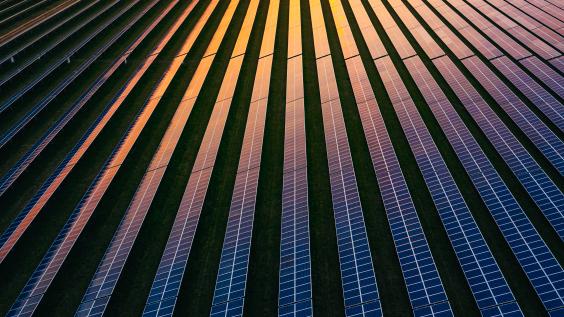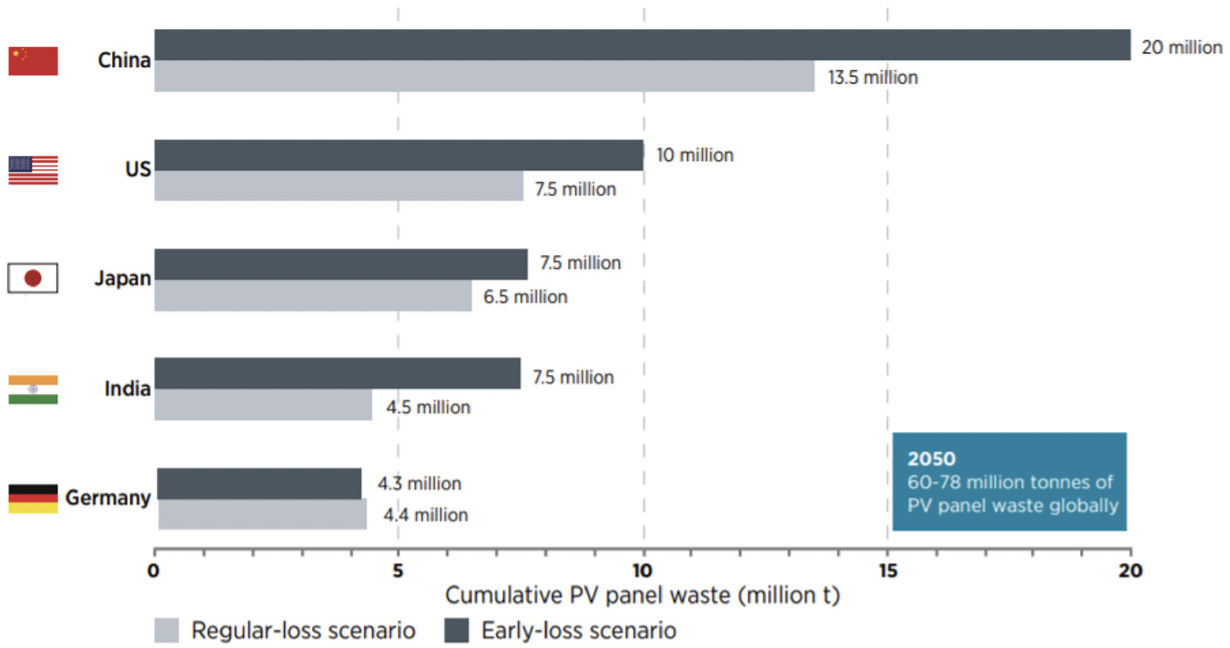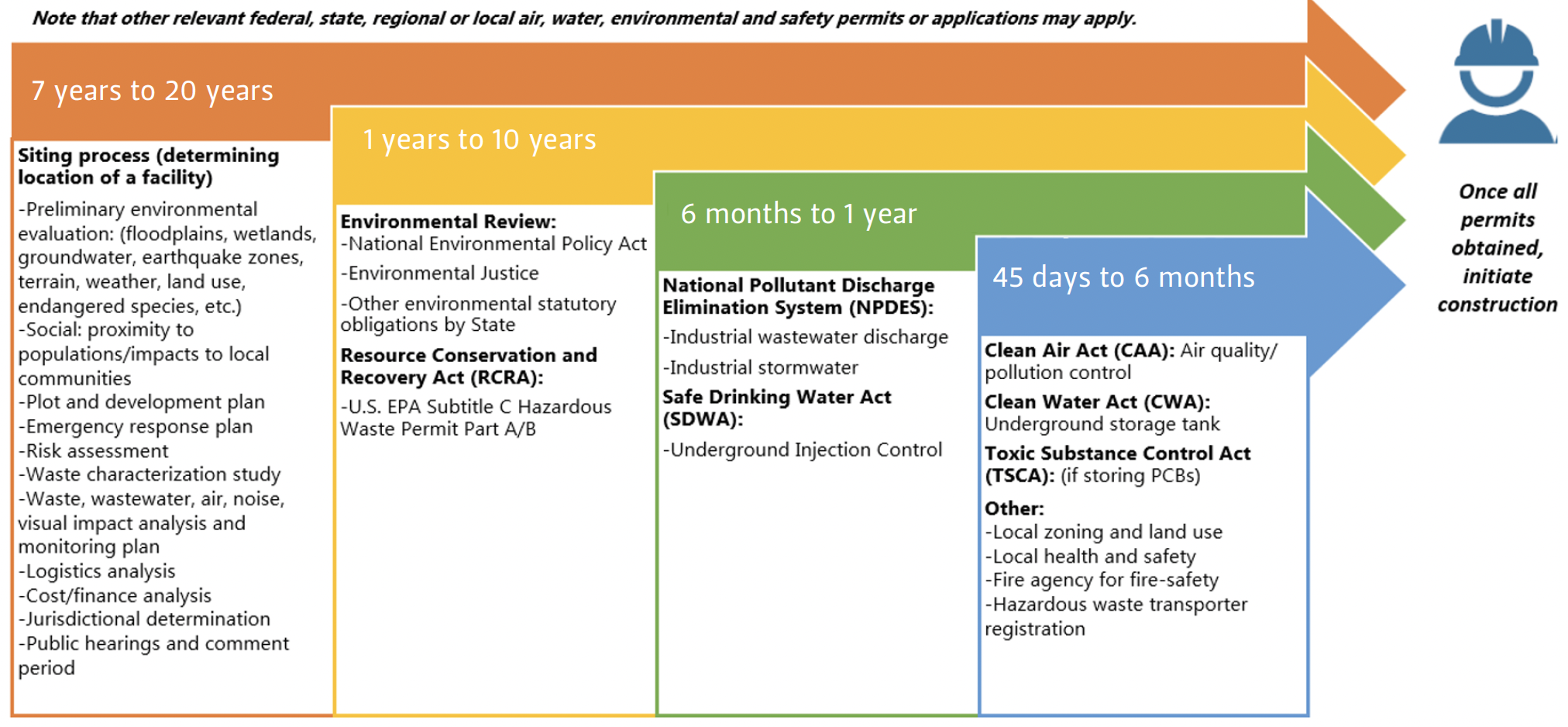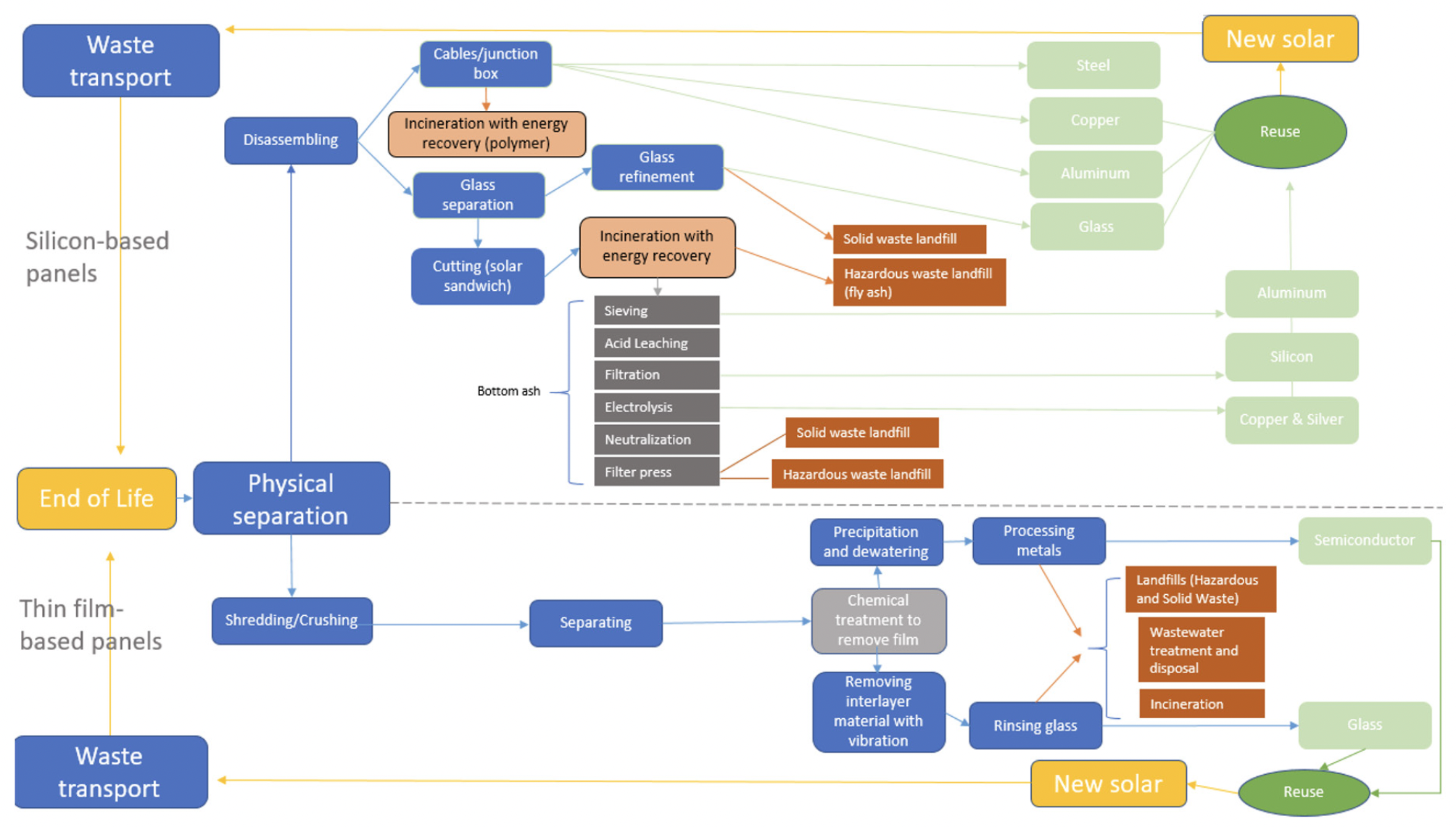Solar’s Bright Future Faces a Cloudy Reality: What About All the Waste?

Table of Contents
Author(s)
Share this Publication
- Download PDF
- Print This Publication
- Cite This Publication Copy Citation
Rachel A. Meidl, “Solar’s Bright Future Faces a Cloudy Reality: What About All the Waste? End-of-Life Solar Panels: Federally Classified Hazardous Waste” (Houston: Rice University’s Baker Institute for Public Policy, January 12, 2022), https://doi.org/10.25613/D721-VE78.
With the immediate pressures of climate change and the urgency to incorporate alternative energy resources like wind and solar, there is an overt focus on the benefits of these energy transition technologies, but a clear absence of strategy around identifying and quantifying other externalities, such as waste disposal or associated environmental impacts. Dissecting a solar photovoltaic (PV) panel and understanding its anatomy reveals an intricate and highly integrated system that makes dismantling and recycling an expensive, complicated, and energy-intensive process. A panel may contain an assortment of metals, including cadmium, chromium, lead, selenium, and silver, among others. The presence of these heavy metals and other constituents causes end-of-life solar panels to exhibit characteristics of toxicity and thus to be classified as hazardous waste by U.S. federal regulations.1 If not properly managed, rudimentary recycling and improper disposal of panels could impact human health and the environment. The panels also include aluminum, glass, complex plastics, and other materials that may or may not be recoverable or recyclable due to technological constraints, the low value of the materials, and the high cost of recycling.
Waste management considerations for the influx of end-of-life solar panels and other energy transition technologies, like lithium-ion batteries from electric vehicles and energy storage devices, rarely reach the level of priority on national agendas. The energy industry, governments, and society have yet to fully confront the long-term waste stream quantities and implications for these systems. If a sustainable and circular future is the preferred way forward, management in permitted recycling, treatment, and disposal facilities is necessary. It is vital that we plan, prepare, and design energy systems for reuse, recovery, remanufacturing, and recycling in the present—or we risk creating new environmental, social, and economic burdens in the future.
End-of-life management for solar panels can be a significant component of the solar value chain. Unlocking raw materials and other valuable elements can generate new industries, create considerable economic value, and support a global shift to a circular economy.
Solar’s Continual Growth
In the first half of 2021, nearly 11 GWdc (gigawatts, direct current) of solar have come online in the United States—more than most of the annual installation volumes from the past decade. The Solar Energy Industries Association reports that solar PV accounted for 56% of all new electricity-generating capacity additions in the United States in the first half of 2021. Over the next 10 years, 324 GW of new solar capacity may be installed, three times greater than the amount installed through 2020.2 Solar continues to comprise the largest share of new generating capacity in the United States.
Even throughout the COVID-19 pandemic, the federal solar investment tax credit (ITC)3,4 has continued to boost project economics and incentivize the rapid installation and trade-in of existing panels for newer, cheaper, more efficient models, driving some of the anticipated solar growth. Since the ITC was enacted in 2006, the U.S. solar industry has expanded by more than 10,000%.5 The industry will continue to break annual installation records every year for the next three years before the ITC winds down under current law. After 2023, the tax credit will decrease to a permanent 10% for commercial installers and will be withdrawn entirely for homeowners. This will cause sales of solar panels to become even more attractive in the coming months, as buyers race to cash in while opportunity still exists. Meanwhile, additional incentives are being proposed in Congress.
Aside from attractive tax subsidies that have resulted in massive and unprecedented solar growth, the conversion efficiency of panels has improved year after year, thanks to manufacturing innovations in China, which dominates and controls the solar market. In 2019, China produced 80% of the world’s supply of solar panels6 and currently controls 70% of the world's supply of polysilicon, a critical raw material needed for panels.7 To manufacture the panels, Chinese firms rely to a large extent on coal-powered electricity.8 The final products are then transported thousands of miles overseas to importing countries such as the United States, where they are ironically upheld as a pillar of “clean energy” programs.
For the end consumer, tax subsidies, conversion efficiencies, and ever-evolving innovations amount to far lower upfront costs per kilowatt of energy generated. But this also results in the rapid obsolescence and early retirement of older, less efficient panels and panels that still have 10-15+ years of life remaining in their 25-to-30- year lifespan.9 This will create enormous amounts of waste that have not been factored into existing projections. Solar waste currently has limited or no end-of-life options other than landfilling, incineration, or “donations” (volunteer recycling) to secondary markets.
In an industry that is touted as an ideal solution to combat climate change, an attractive investment for companies and investors that aligns with their environmental, social, and governance goals, and a job creator for the United States, the looming waste volumes run counter to a circular economy and pose a threat to global and national sustainability goals.
Solar’s Waste Management Conundrum
Currently, cumulative solar waste projections worldwide are anticipated to reach between 4% and 14% of total solar generation capacity by 2030 and could rise to over 80% (around 78 million tonnes) by 2050 (Figure 1).10
Figure 1 — Cumulative Waste Volumes of Top Five Countries for End-of-Life PV Panels in 2050

Early replacement and widespread premature decommissioning of panels—driven by the ITC, conversion efficiencies, compensation rates, installation prices, severe weather events, and other factors—could push those numbers even higher. Most forecasts also assume the full 25-to-30-year lifespan of panels and that installers will take ownership and responsibility for removal and disposal of both residential and commercial installations. This is not the case. Due to limited resources, storage, and transportation options under current waste laws, as well as the need to verify the legitimacy of possible recycling or reuse outlets, installers have no incentives to manage the panels that they are replacing.
The entire end-of-life process for solar panels is deeply complex and relatively uncharted territory. The systems that govern state and federal hazardous waste laws are not yet adapted to handle alternative energy waste. Solar panels often contain an array of metals, including cadmium, chromium (older silicon solar panels can contain hexavalent chromium coatings), copper, lead, selenium, antimony, silver, gallium, tellurium, and others. The presence of these metals may cause end-of-life panels to exhibit characteristics of toxicity, which has resulted in their classification as hazardous waste under the Resource Conservation and Recovery Act (RCRA), the federal statute governing the management of hazardous waste. This classification brings solar panels under the full spectrum of the U.S. Environmental Protection Agency’s (EPA) hazardous waste regulations and carries a host of stringent regulatory obligations that make it expensive and burdensome to classify, store, handle, and transport panels for recycling or disposal under existing law.
Current regulations require waste generators (handlers, installers, shippers, storage facilities, and manufacturers) to conduct a “hazardous waste determination” assessment that establishes whether toxic substances are present and in what quantities.11 Testing to determine if something is deemed “hazardous” under federal law can cost anywhere from $700 to $1,500. A representative sample of each waste stream is required to be tested (i.e., each panel, unless a generator has the same model/manufacturer that can apply to all units). Because certified laboratory analytical testing is costly, many opt to simply classify and manage solar panels as hazardous waste using “generator or process knowledge”12 to avoid testing and the risk of fines. However, most entities managing end-of-life solar panels are unaware of their hazardous classification and the subsequent regulatory obligations.
If a generator of solar panel waste produces over 220 pounds per month (equivalent to approximately five panels), there are on-site accumulation and storage time limits as well as transport quantity limitations per shipment. Additionally, the EPA must be notified, and an EPA ID number will be issued. Compliance with all applicable U.S. Department of Transportation permits and regulations for hazardous materials, including the use of a uniform hazardous waste manifest, is also required.13 Shipments of regulated hazardous waste can only be routed to permitted treatment, storage, and disposal facilities or recyclers. Also under current regulations, any dismantling or removal of panel components, such as the aluminum frame, is defined as “treatment”14 and requires a permit with the EPA.15
A complicating factor is understanding what constitutes “solar panels” for the purposes of waste regulation. Do solar cells, PV modules, PV systems, solar-powered devices, solar concentrators, or electronic devices (e-waste) fall into the same category? These intricate regulatory obligations, along with the direct cost of recycling, encourage abandonment, illegal dumping, and stockpiling of waste solar panels until more affordable options emerge.
Permits, Timelines, and Ever-Increasing Waste Volumes
Scaling a robust recycling and hazardous waste industry to adequately support the influx of alternative energy technologies is a complex, extensive, and protracted process that involves multiple agencies and jurisdictions. The entire process—from facility siting and lengthy environmental reviews to construction—can span decades (Figure 2). Solar panels and other energy transition technologies (e.g., lithium-ion batteries from electric vehicles and energy storage systems) are currently classified as regulated hazardous waste and are subject to the full RCRA Part A/B operating permits. This kind of waste must be routed to and managed by qualified facilities.
Figure 2 — Timeline for Siting and Permitting Hazardous Waste Facilities to Treat, Store, and Dispose of Waste

Note In the U.S., depending upon state and location, it can take seven to 20 years before initiating construction (and up to 20+ years for completion) of a hazardous waste/recycling facility that is certified to treat, store, and dispose lithium batteries, solar, and other energy transition waste.
The problem is that recycling technologies for solar panels around the world, and in particular in the United States, are still nascent and cost prohibitive. This limits the final disposition options to landfill, incineration, or export—the least expensive pathways by a wide margin. Although precise figures are difficult to obtain due to the misclassification of panels as e-waste or other materials and the lack of tracking mechanisms and data transparency, estimates are that approximately 10% of solar panels are recycled in the United States, at best.16 Most of this crude recycling occurs at general-purpose glass recycling facilities, e-waste facilities, or scrap yards where rudimentary dismantling and processing techniques pulverize the variety of complex modules within a panel and separate the higher value materials (e.g., the aluminum frame) for scrap metal. The remainder of the materials are either discarded in the general trash, stockpiled (awaiting regulatory certainty or the availability of economically viable recycling), abandoned, or improperly misrouted to municipal landfills that are not equipped nor permitted to manage hazardous waste.
Although Europe is making headway in scaling solar recycling, much of the effort in Europe, Japan, and the United States is concentrated on research and development of silicon-based panels and recovering and recycling only the most economical components.17 Given the massive projected volumes of solar waste in the coming future, it is uncertain whether existing waste and recycling facilities are adequate to manage the influx of panels to meet zero-waste and sustainability targets.
Figure 3 — The Complexity of the Solar Recycling Process

Recycling processes can vary depending on the type and composition of the solar panel.18 Generally, the process involves a combination of physical disassembly, shredding, and separation, as well as thermal and chemical treatments (Figure 3). During the initial disassembly process, the aluminum frame and the cables/junction box are separated from the layer of photovoltaic cells, glass, and polymers.19,20 The aluminum is routed for refining, while the polymers from the cable are incinerated with energy recovery. Cables and connectors are crushed and sold in the form of copper shot. The glass separation process involves placing the panels into a furnace with a controlled atmosphere to separate the glass from the photovoltaic sandwich module of ethylene vinyl acetate (EVA), which contains silicon metal, polymers, and other materials. The PV sandwich module is cut, and optical glass separation segregates the pieces of clean glass from those contaminated by polymers through sieving. The recovered glass is then sent to a glass recycler, while residuals are landfilled. The encapsulation layer—a polymer used for electrical insulation and binding PV components together to protect them from foreign impurities, moisture, and mechanical damage—is incinerated with energy recovery. The halogenated backsheet, which can contain polyvinyl chloride (PVC) or polyvinyl fluoride (PVF), is incinerated with energy recovery at a permitted waste facility. The fly-ash from the incineration process, which contains hazardous metals, is sent to a permitted hazardous waste landfill. Other plastics are used as fuel in cement manufacturing (to reduce emissions from CO2-intensive cement production). Residual ash from the incineration processes, which contains silicon and other metals, is collected. The ash goes through a nitric acid leaching process to extract the silicon and other metals, dissolving the metals to create metal oxides and leaving silicon in the residues. The remaining silicon and other dissolved metals in the acid solution are subsequently treated in a vacuum filtration process and can be sent to various metal sectors. The metals present in the residuals after the leaching (silver, copper, lead, tin, etc.) can be recovered through electrolysis. All other remaining metal residues in the acid solution require further neutralization through the addition of calcium hydroxide. The final output is a sludge containing calcium nitrate, residual calcium hydroxide, and unrecovered hazardous metals. This sludge is filtered and transported to a hazardous waste landfill for final disposal.
Although a first-of-its-kind method in Europe for recycling solar panels maintains that it is technically possible to recover and repurpose almost 95% of the components of a panel,21 it remains difficult to achieve due to the challenges of transparently tracing and verifying the process using current policy frameworks, business models, and antiquated cradle-to-grave tracking and accounting methodologies.
Additionally, solar recycling is not a standalone operation that occurs in one location—it involves partnerships and access to multiple actors across the end-of-life value chain, including solar waste collectors, solar recyclers, hazardous waste transporters, landfill and incinerator operators, and end market consumers. Recycling can also be an energy- and resource-intensive process and generates its own waste and emissions throughout the many stages of transport, disassembly, shredding, thermal treatment, chemical precipitation, acid leaching (to recover silicon metal from the ashes), chemical etching with acids and peroxides, melting, etc.
Although the solar recycling industry faces challenges of insufficient inputs, high operating costs, and low profitability due to small concentrations of valuable materials, there is compelling data to support the potential for a strong solar recycling market if infrastructure and supply chain collaborations existed to collect, process, and sell the various components. However, none of these arrangements are currently in place. To work through this techno-economic conundrum, we should develop new circular business models and establish secondary markets based on recycled, reused, and recovered silicon, metals, and other materials for second-life panels and other applications that formalize reuse, repair, and remanufacturing value chains in the solar PV industry.
So far, the recycling process for solar panels results in a net cost activity when compared to landfilling—due to the avoidance of the true environmental costs and externalities for the latter. However, in the long term, recycling can ensure the sustainability of the supply chain, increase the recovery of energy and embedded materials, and reduce CO2 emissions and energy payback time for the whole PV industry. The unprofitability of current methods should not be used to suggest that recycling is not worth pursuing. Conversely, the management of end-of-life PV waste has the potential to develop new circular pathways for industry and offers employment prospects to investors in both the public and private sectors. Recycling can capture and retain hazardous materials (e.g., lead, cadmium, and selenium) and recover rare elements (e.g., tellurium and indium) and other metals (e.g., silver), making them available for future use. To achieve economic viability and efficient circularity at acceptable costs, it is essential that actors across supply chains collaborate to ensure future recycling processes stay current with the continuous innovations in solar cells and modules technologies.
Solar power is becoming ubiquitous in emerging markets. In the last decade, developing countries made substantial strides in attracting alternative energy capital and building unprecedented volumes of solar capacity. Global installed solar in these markets jumped from 1 GW a decade ago to an astonishing 325 GW as of year-end 2019.22 While Europe, the United States, and Japan led the way in early solar installations, most growth has been driven by developing countries over the past several years, with China in particular starting to dominate the solar sector. Emerging markets now account for the majority of growth in solar power.23 However, formal waste disposal networks, recycling infrastructure, and regulations are lacking—especially in the developing economies that are experiencing this unprecedented growth. The deficiency of hazardous waste policies—and the absence of secure and permitted landfills if recycling is not available in these regions—could exacerbate the already growing volumes of waste that are abandoned in the environment.
Future Regulatory Models
A national framework for end-of-life solar waste in the United States does not exist, but following California’s lead, the EPA is currently weighing whether panels should be regulated as “universal waste,”24 a category of hazardous waste with streamlined regulations intended to reduce management burdens and facilitate collection and recycling. There is also no established infrastructure for collection and transportation, which is why solar PVs are presently managed under the robust RCRA laws. Contrast that to the European Union (EU), where since 2012 solar panels were covered under the Waste Electrical and Electronic Equipment Directive (WEEE) that requires 85% of panels to be collected for proper disposal and 80% of the materials used in the panels to be recycled. And since 2014, the collection, transport, treatment, and recycling of PV panels was regulated in every single EU country. From a regulatory point of view, the EU is the only territory to adopt PV-specific waste regulations, including collection and recovery targets, as well as the only territory to finance arrangements for initiating large-scale PV module recycling practices. From a global perspective, the capabilities and regulations of developing nations and emerging markets are likely to lag behind the waste disposal and recycling policies of the United States and the EU.
California, home to 60% of installed solar capacity in the United States, is the first state to regulate end-of-life solar panels as universal waste. Although the law was passed in 2015 and the new regulations took effect in 2021, the state is encountering initial implementation and interpretation challenges while the deficient collection, transport, and recycling infrastructure develops. It is conceivable that the EU’s WEEE Directive or California’s recent law will serve as a regulatory model for future development of a national solar waste recycling framework and a blueprint for other states and nations to follow. In 2017, Washington state required manufacturers of solar panels to finance the takeback and recycling system at no cost to the owner of the PV module. This configuration is analogous to the EU system where recycling responsibilities for past (historic) waste are apportioned to manufacturers based on current market share. Hawaii, North Carolina, and Rhode Island are also considering rules for governing solar panels in order to stimulate recycling. As the solar recycling industry emerges and numerous players enter the market, one of the biggest challenges will be assigning responsibility for the vast amount of accumulated orphan waste generated by companies no longer in the solar and electronics business.
Anatomy of a Solar Panel—Yes, Plastics
The reality omitted from the energy transition discourse is just how valuable plastics are in electrification and decarbonization strategies. There is a societal disregard for the economics of hydrocarbons, the building blocks of plastics, and the fundamental role they have in a diversified energy future. Actions to ban plastics or to restrict the extraction, production, and use of fossil fuels run counter to the principles of supply and demand, especially in an era where society wants to rapidly accelerate the production of electric vehicles (plastics account for approximately 50% of the volume of every car, and this is likely to increase as vehicles are “lightweighted” to offset the weight of lithium-ion batteries),25 wind energy (blades are constructed from plastic thermoset resin), and solar energy (approximately 10% of each solar panel is comprised of plastics).
Aside from the aluminum frame, tempered glass, metallic conductors, silicon layers, and cells, solar panels use several varieties of plastics including ethylene vinyl acetate (a thermoplastic used as an encapsulant); polyvinyl fluoride (a specialty plastic in the backsheet for chemical and UV resistance); acrylonitrile butadiene styrene (used for braces and attachments); acrylic/ plexiglass (used for protective and insulating films); polypropylene (used as a protective film for glass panels or as a base material for plastic solar cells), and others.
Aluminum and glass manufacturing is highly energy intensive, has significant environmental impacts, and releases a large proportion of energy as waste heat.26, 27, 28 Several companies are migrating away from the standard aluminum and glass solar panels in favor of plastic units in a bid to lower their weight, emissions, and costs, as well as for added flexibility.29 Solar panels manufactured from plastics can be made to be 50% lighter, are sourced from post-consumer recycled polycarbonate (which will lower the emissions of the frame), and can be disassembled more easily. The plastics in the panels can also be recycled at the end-of-life with the proper regulatory incentives. The plastics are highly resistant to corrosion and impacts, and extremely resistant to UV damage. Additionally, consistent with a circular economy, by using certified recycled plastics from domestic advanced recycling technologies as feedstock, the quality of the plastics and the energy source during the manufacturing phases can be verified, as opposed to the coal-produced panels manufactured in China.
Solar, Sustainability, and a Circular Economy
Recycling—or the proper disposal of hazardous materials if recycling is not possible—is indeed an essential component of a circular economy. However, first and foremost, we need enabling regulations that incentivize collection and proper end-of-life management of solar waste. This can help build solar recycling capacity while industry and secondary markets scale as part of a comprehensive end-of-life infrastructure. In the rush to decarbonize and electrify our society, waste management is oftentimes overlooked.30 The dearth of end-of-life data and the existence of policies not well adapted to a diversified energy future fail to capture the full extent of the evolving waste crisis, detract from the vision of sustainability, and leave society vulnerable and unprepared for the demands of a circular economy.
Decarbonization strategies and climate policies should be guided by the foundations of sustainability and a circular economy. Policies should account for the full range of life-cycle impacts that connect materials to the end product and the globally complex supply chains that map where materials come from, how they are processed and manufactured, the manner in which they are used, and how they will be managed at the end of life.
The current life-cycle management of solar panels contradicts the principles of sustainability and a circular economy. A circular economy replaces the end-of-life concept with restoration, increases resource efficiency, keeps materials in use and at their highest value throughout their life, and encourages innovation, responsible sourcing, recycling, reuse, repair, and remanufacturing. Building resilience and developing sustainability require a collective and systems-based thought process to ensure long-term prosperity while contributing to social and economic development, a healthy environment, and a thriving society for current and future generations.
The development of a circular economy model based on PV waste manufacturing and end-of-life modules for reuse in the solar sector or other industrial sectors is important for sustainability. Opportunities exist for developing properly scoped methodologies that account for the life-cycle impacts of commonly overlooked factors of at-scale solar installations—such as land use/land competition, biodiversity loss, environmental justice, water management, and global transportation networks. Additionally, technologies such as blockchain can necessitate and provide great impetus for a transparent, accountable, and more circular and sustainable management system for end-of-life panels in the complex global waste and resource management network.
Endnotes
1. “Identification and Listing of Hazardous Waste,” 40 C.F.R. § 261, last amended December 15, 2021, https://www.ecfr.gov/current/title-40/chapter-I/subchapter-I/part-261.
2. SEIA (Solar Energy Industries Association), “Solar Data Cheat Sheet,” September 14, 2021, https://www.seia.org/sites/default/files/2021-09/SMI-September-2021-SolarCheatSheet.pdf.
3. Utility-scale solar projects that start construction in 2021 or 2022 are eligible for a 26% tax credit. The tax credit drops to 22% for projects that start in 2023 and to 10% for projects that start in 2024 or later. After 2023, the tax credit will decrease to a permanent 10% for commercial installers and will disappear entirely for home buyers.
4. SEIA, “Solar Investment Tax Credit (ITC),” Factsheet, January 2021, https://www.seia.org/sites/default/files/2021-01/SEIA-ITC-Factsheet-2021-Jan.pdf.
5. SEIA, “Solar Investment Tax Creidt (ITC),” 2021, https://www.seia.org/initiatives/solar-investment-tax-credit-itc#:~:text=The%20residential%20and%20commercial%20solar,over%20the%20last% 20decade%20alone.
6. Emily Chow, “China's solar glass shortage to drag on panel output into 2021,” Reuters, December 3, 2020, https://www.reuters.com/article/china-solar-glass-idAFL1N2IJ0E2.
7. According to the consultancy IHS Markit Ltd.
8. Dan Murtagh, “Why It’s So Hard for the Solar Industry to Quit Xinjiang,” Bloomberg Green, February 10, 2021, https://www.bloomberg.com/news/articles/2021-02-10/why-it-s-so-hard-for-the-solar-industry-to-quit-xinjiang.
9. Benjamin Mow, “STAT FAQs Part 2: Lifetime of PV Panels,” NREL Conduit Blog, April 23, 2018, https://www.nrel.gov/state-local-tribal/blog/posts/stat-faqs-part2-lifetime-of-pv-panels.html.
10. Stephanie Weckend, Andreas Wade, and Garvin Heath, “End-of-Life Management: Solar Photovoltaic Panels,” IRENA and IEA-PVPS, 2016, https://energycentral.com/system/files/ece/nodes/451407/irena_end_of_life_management_ solar_pv.pdf.
11. EPA (U.S. Environmental Protection Agency), “Defining Hazardous Waste: Listed, Characteristic and Mixed Radiological Wastes,” https://www.epa.gov/hw/defining-hazardous-waste-listed-characteristic-and-mixed-radiological-wastes.
12. “Hazardous waste determination and recordkeeping,” 40 C.F.R. § 262.11, Legal Information Institute, https://www.law.cornell.edu/cfr/text/40/262.11.
13. EPA, “Uniform Hazardous Waste Manifest: Instructions, Sample Form and Continuation Sheet,” https://www.epa.gov/hwgenerators/uniform-hazardous-waste-manifest-instructions-sample-form-and-continuation-sheet.
14. Pursuant to 40 C.F.R § 260.10: Any method, technique, or process, including neutralization, designed to change the physical, chemical, or biological character or composition of any hazardous waste so as to neutralize such waste, or so as to recover energy or material resources from the waste, or so as to render such waste non-hazardous, or less hazardous; safer to transport, store, or dispose of; or amenable for recovery, amenable for storage, or reduced in volume.
15. “Hazardous Waste Management System: Definitions,” 40 C.F.R § 260.10, July 1, 2012, https://www.govinfo.gov/app/details/CFR-2012-title40-vol27/CFR-2012-title40-vol27-sec260-10.
16. Taylor L. Curtis, Heather Buchanan, Garvin Heath, Ligia Smith, and Stephanie Shaw, “Solar Photovoltaic Module Recycling: A Survey of U.S. Policies and Initiatives,” National Renewable Energy Laboratory, Technical Report, March 2021, https://www.nrel.gov/docs/fy21osti/74124.pdf.
17. Md. Shahariar Chowdhury et al., “An overview of solar photovoltaic panels’ end-of-life material recycling,” Energy Strategy Reviews 27 (January 2020), https://doi.org/10.1016/j.esr.2019.100431.
18. Photovoltaic cell technologies are divided into the following four generations: (1) first generation: wafer-based crystalline silicon; (2) second generation: thin films; (3) third generation: organic, nano-crystalline films; and (4) fourth generation: hybrid polymer thin films with inorganic nanostructures.
19. Marina Monteiro Lunardi, Juan Pablo Alvarez-Gaitan, Jose I. Bilbao, and Richard Corkish, “A review of recycling processes for photovoltaic modules,” Solar Panels and Photovoltaic Materials (July 2018): 9-27, https://doi.org/10.5772/intechopen.74390.
20. Chowdhury et al., “An overview of solar photovoltaic panels.”
21. “Veolia opens the first European plant entirely dedicated to recycling photovoltaic panels,” Veolia, July 5, 2018, https://www.veolia.com/en/newsroom/news/recycling-photovoltaic-panels-circular-economy-france.
22. Luiza Demôro, Sofia Maia, and Felicia Aminoff, “Climatescope 2021: Energy Transition Factbook,” BloombergNEF, December 2021, https://global-climatescope.org/downloads/climatescope-2021-report.pdf.
23. Demôro, Maia, and Aminoff, “Climatescope 2021.”
24. EPA, “Universal Waste,” https://www.epa.gov/hw/universal-waste.
25. American Chemistry Council, “Chemistry in Automotive,” https://www.americanchemistry.com/chemistry-in-america/chemistry-in-everyday-products/automotive.
26. Daniel Brough and Hussam Jouhara, “The aluminium industry: A review on state-of-the-art technologies, environmental impacts and possibilities for waste heat recovery,” International Journal of Thermofluids 1-2 (February 2020), https://doi.org/10.1016/j.ijft.2019.100007.
27. U.S. Energy Information Administration, “Glass manufacturing is an energy-intensive industry mainly fueled by natural gas,” August 21, 2013, https://www.eia.gov/todayinenergy/detail.php?id=12631.
28. “The major environmental impact of glass production is caused by atmospheric emissions from melting activities,” AGC Glass Europe, https://www.agc-glass.eu/en/sustainability/environmental-achievements/environmental-impact.
29. John Fitzgerald Weaver, “Plastic for Solar Panels?” PV Magazine, October 26, 2021, https://www.pv-magazine.com/2021/10/26/plastic-for-solar-panels/.
30. Rachel Meidl, Waste Management and the Energy Transition: The Path to Sustainability and a Circular Economy. Policy brief: Recommendations for the New Administration. February 20, 2021, Rice University’s Baker Institute for Public Policy, Houston, Texas, https://doi.org/10.25613/DJ5H-D776.
This material may be quoted or reproduced without prior permission, provided appropriate credit is given to the author and Rice University’s Baker Institute for Public Policy. The views expressed herein are those of the individual author(s), and do not necessarily represent the views of Rice University’s Baker Institute for Public Policy.



